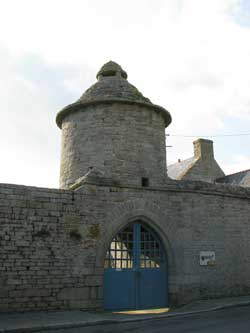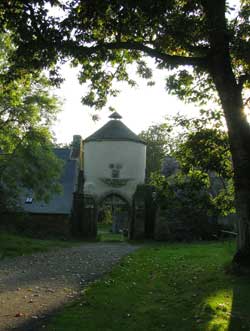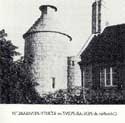
 |
 |
| Dovecote of Kergoz, of Guilvinec |
|
The manor of Kergoz is also known as the castle of Bodinio, and the entire compound is built in the style of a fortress, abeit a small one. The ramparts, with corner towers and loopholes, looks rather like a keep from out at sea. Perhaps this design was used intentionally for discouraging pirates. It could also, of course, have provided a modecum of protection. The surrounding wall, door, and the dovecote are listed historic monuments. The name suggests that the origins are prior to the 14th century, but the manor’s main feature is the 16th century dovecote. A rather unusual, although not singular, feature of the dovecote is that it is built over the entryway of the seignorial courtyard, confirming that the owners were part of the nobility. You can get a better view of how the dovecote is constructed over the entryway by clicking on the picture on the left to open a larger image. The property belonged to Alain Penalen in 1426. By the 17th century, it was the property of Guy Autret de Missirien. The property is now owned by the city and can be viewed. Unfortunately, we arrived too late in the day and the facility was closed, so we were not able to inspect the dovecote and provide you with more elaborate detail.
It can be found by traveling toward the center of Guilvinec from the north on the D57. From within the village of Guilvinec, it is well sign posted..
 |
Dovecote of Lesmadec in Peumerit |
This dovecote, as with the one of Kergoz, above, is of a most unusual design, being built directly into and on top of the gate to the home. It is not large in size, being only about 16 feet wide and tall. It is accessed by an external staircase from inside the wall, which leads up to a small service door. There is a slightly larger course of stones just below the roof, and the slate roof rests on these stones. The cupola also has a shale roof. The dovecote's exterior wall appears to have been recently re-plastered. I can’t help but smile with the folks who replastered the dovecote. It is quite obvious that they intentionally did not plaster over the stones that make up the smilling face on the "front" of the dovecote.
The dovecote is of the 16th century, and belonged to the Forester family, Magistrates of Quimper, through the 18th century.
To find this dovecote, travel 1 km from Peumerit on the road toward Ploggstel-St. Germaine & Quimper, and turn left at the intersection. There will be a sign on the immediate left noting the drive to Les Madec. The drive is not indicated as private property, so we drove down the lane to where it ends at the gate and took this rather nice picture.

|
Dovecote of Kernuz, Point-L' AbbotThe most unique feature of this more typical round dovecote of stone with a stone stepped roof is the entry door. It is a Moorish arch, or keyhole shape. The dovecote can be found by traveling north on the D785 into Pont L’Abbe. Just before the first roundabout into town, take the first right onto a very small road from which the manor and dovecote can be seen. Other dovecotes in the area reported by Dr. Jean Auffret in Colombiers et Pigeonniers en Bretagne Profonde are noted below. We have provided small thumbnail images from the book to help you identify them. More detail on these dovecotes and larger images are in the book, which we highly recommend for any enthusiast. And of course, if you have any information on any of these or others you know of in the area that you would like to share, we would love to post it . |
Dovcote of Kernuz, Point-L' Abbot |

|
Dovecote of Penmarc Pont, Penmarc h-kerityWhile we were not able to locate this dovecot,e we learned from Dr. Jean Auffret that it is of a round tower type that, while not connected directly to the house, is not free standing either. The tower is of nearly the same height as the home, which would obscure the dovecote unless viewed from the proper angle. The cupola is capped with a stone plate. The base, in corbelling, is square and supports the round tower made of stone. The roof is of stone laid out in the rather standard stair step design of the area. Only the top part of the tower was used for the dovecote, so in all it is rather small with only 260 nestholes, made up of 13 rows with 20 nests in each row.. |
Area between Quimper and Vannes ![]()
DAY |
||||||||||||||||||
| 00 | 01 | 02 | 03 | 04 | 05 | 06 | 07 | 08 | 09 | 10 | 12 | 13 | 14 | 15 | 16 | 17 | 18 | |